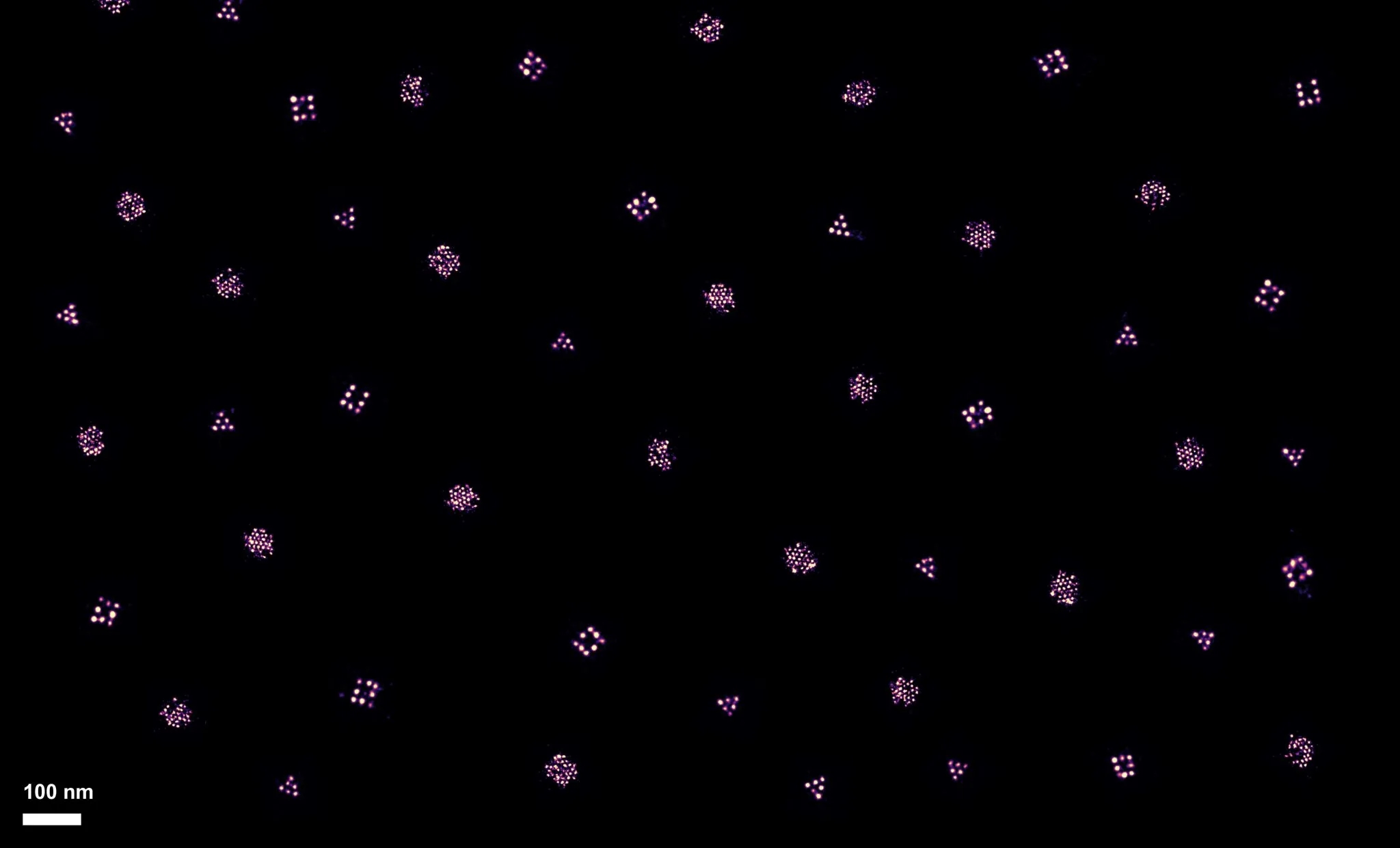博文
科学家解开大自然超选择性结合的秘密
 精选
精选
||
科学家解开大自然超选择性结合的秘密
诸平
Original microscopy data on different ligand patterns on DNA materials Credit: © Bastings/PBL EPFL
据洛桑联邦理工学院(Ecole Polytechnique Fédérale de Lausanne简称EPFL)2023年1月18日报道,EPFL的科学家解开大自然超选择性结合的秘密(Scientists Unlock Nature’s Secret to Super-Selective Binding)。
EPFL的研究人员发现,控制纳米材料与蛋白质表面之间的超选择性结合相互作用不仅取决于分子密度,还取决于模式和结构刚性。这一突破有可能优化现有的病毒预防和癌症检测技术。
很多生物学都归结为结合的生物物理过程:在一组或多组被称为配体的原子与表面上相应的受体分子之间建立强烈的连接。结合事件是允许病毒感染宿主或化疗来对抗癌症的第一个基本过程。但至少在结合相互作用上,我们对它们的理解存在一个“金发姑娘问题(Goldilocks problem)”:一个分子上的配体太少,就不可能稳定地与正确的目标结合,而过多的配体又会导致不良的副作用。
EPFL工程学院(School of Engineering, EPFL, Lausanne, Switzerland)可编程生物材料实验室(Programmable Biomaterials Laboratory简称PBL)负责人马特杰·巴斯廷斯(Maartje Bastings)解释说,当结合被目标受体的阈值密度(threshold density)触发时,我们称之为超选择性结合,这是防止可能失调生物功能的随机相互作用的关键。由于自然界通常不会使事情过于复杂,我们想知道仍然允许发生超选择性绑定的最少数量的绑定相互作用。我们还想知道配体分子的排列方式是否会对选择性产生影响。事实证明,确实如此!
马特杰·巴斯廷斯和她的4个博士生于2022年11月16日已经在《美国化学学会杂志》(Journal of the American Chemical Society)网站上发表了一项研究,确定了超选择性结合的最佳配体数量为6。但令他们兴奋的是,他们还发现,例如,这些配体在直线、圆圈或三角形中的排列也显著影响了结合效果。他们将这种现象称为多价模式识别(multivalent pattern recognition简称MPR)。详见Hale Bila , Kaltrina Paloja, Vincenzo Caroprese, Artem Kononenko, Maartje M C Bastings. Multivalent Pattern Recognition through Control of Nano-Spacing in Low-Valency Super-Selective Materials. Journal of the American Chemical Society, Publication Date: November 16, 2022, 144(47): 21576–21586. DOI: 10.1021/jacs.2c08529. https://pubs.acs.org/doi/10.1021/jacs.2c08529
“MPR开启了围绕生物过程和免疫过程中的分子通信是如何工作的一套全新的假说。例如,SARS-CoV-2病毒有一种用于与细胞表面结合的刺突蛋白(spike proteins)模式,在选择性方面,这些模式可能非常关键。”
从冠状病毒到癌症(From coronaviruses to cancer)
由于DNA的双螺旋结构是如此精确和易于理解,因此它是PBL研究的完美模型分子。在这项研究中,研究小组设计了一个完全由DNA制成的刚性圆盘,所有配体分子的位置和数量都可以被精确控制。在设计了一系列配体-受体结构以探索密度、几何形状和纳米间距如何影响结合的超选择性之后,该团队意识到刚性是一个关键因素。马特杰·巴斯廷斯总结道,“越灵活,精确度就越低。我们的目标是尽可能以极简的方式制定设计原则,以便每个配体分子都参与结合相互作用。我们现在拥有的是一个非常好的工具箱,可以进一步开发生物系统中的超选择性结合相互作用。”
这种工具箱的应用是深远的,但马特杰·巴斯廷斯看到了3个立即有价值的用途。她说,“不管你喜不喜欢,在病毒学应用方面,目前人们首先想到的是SARS-CoV-2病毒。根据我们研究的见解,人们可以想象开发一种具有配体模式的超选择性颗粒,设计用于与病毒结合以防止感染,或阻断细胞部位以使病毒无法感染它。”
诊断方法和治疗方法,如化疗,也可以受益于超选择性,这可以允许更可靠地与癌细胞结合,已知某些受体分子具有较高密度。在这种情况下,健康的细胞不会被检测到,从而大大减少了副作用。
最后,这种选择性工程可以为免疫系统内复杂的相互作用提供关键的见解。马特杰·巴斯廷斯说:“因为我们现在可以精确地控制结合位点的模式,在某种意义上,我们可以与免疫系统进行潜在的交流。”
本研究由瑞士国家科学基金会(Swiss National Science Foundation by Eccellenza grant PCEGP2_181137)资助。
上述介绍,仅供参考。欲了解更多信息,敬请注意浏览原文或者相关报道。

Super-selective multivalent ligand-receptor interactions display a signature step-like onset in binding when meeting a characteristic density of target receptors. Materials engineered for super-selective binding generally display a high number of flexible ligands to enhance the systems' avidity. In many biological processes, however, ligands are present in moderate copy numbers and arranged in spatio-temporal patterns. In this low-valency regime, the rigidity of the ligand-presenting architecture plays a critical role in the selectivity of the multivalent complex through decrease of the entropic penalty of binding. Exploiting the precision in spatial design inherent to the DNA nanotechnology, we engineered a library of rigid architectures to explore how valency, affinity, and nano-spacing control the presence of super-selectivity in multivalent binding. A micromolar monovalent affinity was required for super-selective binding to be observed within low-valency systems, and the transition point for stable interactions was measured at hexavalent ligand presentation, setting the limits of the low-valency regime. Super-selective binding was observed for all hexavalent architectures, and, more strikingly, the ligand pattern determined the selectivity onset. Hereby, we demonstrate for the first time that nano-control of geometric patterns can be used to discriminate between receptor densities in a super-selective manner. Materials that were indistinguishable in their molecular composition and ligand valency bound with various efficacies on surfaces with constant receptor densities. We define this new phenomenon in super-selective binding as multivalent pattern recognition.
https://wap.sciencenet.cn/blog-212210-1372656.html
上一篇:免疫疗法:对抗耐药肿瘤的新型二合一武器
下一篇:以中研究人员合作首次观测到二维空间中的切伦科夫辐射现象
